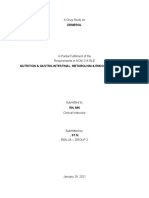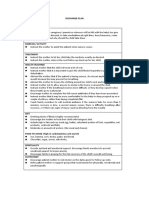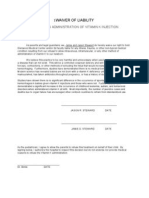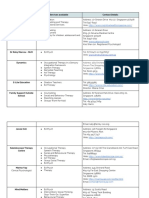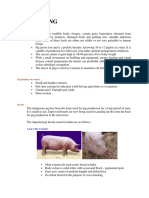Drug Study
Drug Study
Uploaded by
Gladys NacionCopyright:
Available Formats
Drug Study
Drug Study
Uploaded by
Gladys NacionCopyright
Available Formats
Share this document
Did you find this document useful?
Is this content inappropriate?
Copyright:
Available Formats
Drug Study
Drug Study
Uploaded by
Gladys NacionCopyright:
Available Formats
Medications
Name of drug, generic, dosage
Acetaminophenbrand name Paracetamolgeneric name
Indications
Paracetamol is an analgesic and antipyretic drug. It is used for the relief of:
Actions
Nursing considerations
Dosage : Capsule, Granules, Elixir, moderate pain Oral solution, Fever Oral suspension, Migraine Tablets,Supposit Tension ories, Wafers. headaches Adults: 325650 mg q 4 hr; doses up to 1 g q.i.d. may be used. Daily dosage should not exceed 4 g. Pediatric: Doses given 4-5 times/day. Up to 3 months: 40 mg/dose; 4-12 months; 80 mg/dose; 1-2 yrs old; 120 mg/dose; 2-3 yrs; 160 mg/dose; 4-5 yrs; 240 mg/dose; 6-8 yrs; 320 mg/dose; 9-10 yrs; 400 mg/dose; 11-12 yrs; 480 mg/dose. Alternative pediatric dose:
-Inhibits the Administration/storage synthesis 1. Suppositories of prostaglandin should be stored s that may below 80 f (27 serve as C) mediators 2. Treatment of of pain and overdose: fever, primarily initially, induction in the CNS. of emesis, gastric lavage, activated charcoal.Oral Nacetylcysteine is said to reduce/prevent hepatic damage by inactivating acetaminophen metabolites, w/c cause liver effects. CNS stimulation, excitement, delirium are symptoms of toxicity. Have acetylcysteine available for treatment of overdosage. Assessment: 1. If the client is to receive long term therapy, liver function studies should be conducted prior to initiating drug therapy.
10 mg/ kg/dose. Suppositories. Adults, 650 mg q 4- 6 hr not to exceed 6 suppositories per day. Pediatric, Less than 3 yrs: Physician should be consulted; 3- 6 yrs: 120 mg q 4-6 hr, not to exceed 2.6 g/day; 6-12 yrs: 325 mg q 4-6 hr not to exceed 720 mg/day. Buffered. Adult, usual: 1 or 2 three-quarter capfuls are placed into an empty glass of cool water. May be taken while fizzing or after settling. Can be repeated every 4 hr as required or directed by physician.
2. Document presence of fever. Question client concerning pain, noting type, location, duration & intensity INTERVENTION: 1. Note the presence of bluish color of the mucosa-fingernails or clients complaints of dyspnea, weakness, headache or vertigo. These symptoms of methamoglobinemia are caused by anoxia & require immediate action. 2. To assess for evidence of nephritic, check the clients urine for occult blood and the presence of albumin on a routine basis esp. when the client is receiving longterm drug therapy. CLIENT/ FAMILY TEACHING: 1. Teach symptoms of acute toxicity such as nausea, vomiting and abdominal pain. 2. Provide printed information to familiarize clients with the signs and symptoms of severe poisoning. Instruct them to report all such signs and
-The name of the drug is Cyklokapron. -The generic name is Tranexamic Acid. Dosages: Hemophiliac s requiring tooth extraction: IV, immediately before surgery, 10 mg/kg; then, after surgery, tablets, 25 mg/kg t.i.dq.i.d. For 2-8 days. Alternative regimen: PO, 25 mg/kg t.i.dq.i.d. One day prior to surgery. If client unable to take PO medication, give IV, 10 mg/kg t.i.dq.i.d.
-All fibrinolytic bleeding states: Profuse mentrual bleeding, gastrointestina l haemorrhage, haemoptysis, recurrent nosebleeds, bleeding after dental extractions, haemophilia and other bleeding disorders, hereditary angioneurotic edema.
-Tranexamic acid acts by competitively inhibiting activation of plasminogen, thus decreasing the conversion of plasminogen to plasmin( the enzyme that breaks down fibrin clots). Up to 50% of an oral dose is an absorbed from G.I. Tract; absorption is not affected by food. Peak Plasma Levels: 8 mg/L 3 hr after 1 g and 15 mg/L 3 hr after 2 g. Effective Tissue Levels: Maintained for 17 hr. Effective Serum Levels: Maintai ned for 7- 8 hrs. t1/2: 2 hr( after IV use of 1 g). Over 95 % of the drug is excreted via the kidney unchanged.
symptoms. 3. Instruct them to report all such signs and symptoms immediately. Administration Storage 1. tranexamic acid may be mixed with any of the following solutions for IV infusion: Carbohydrate, Amino acid, Electrolyte, Dextran. 2. The mixture should not be prepared on the day of use. 3. The mixture should not be with either blood or penicilin. Assessment: 1. Determine client's blood pressure and pulse before starting IV infusion of drug to establish a baseline against which to measure findings during and after drug therapy. 2. Review client's history and question client/family for evidence of defective color vision. 3. Assess for any evidence of nausea, vomiting, or diarrhea. Intervention: 1. Monitor client frequently for hypotension during IV infusion, which indicates that the rate of infusion is too fast. Slow the rate of infusion and report to the physician. 2. Anticipate reduced dosage in clients with impaired renal function.
-The name of the drug is Natrapharm. -The generic is Fixcom 3. - Dosages: Antituberculosis shortcourse chemotherapy recommended by World Health Organization (WHO) involves an initial phase and a continuation phase. The continuation phase of 4-6 months using combination drugs with the aim of elimination of any remaining organisms and thus preventing recurrence. For the continuation: Fixcom 3 is given for 46 months as follows: Patients <55 kg: 3 tabs/day. Patients 55-70 kg: 4 tabs/day. Patients >70 kg: 5 tabs/day. The tablets should be taken 1 hr before or 2 hrs after meals. -The name of the drug is Vitamin B complex.
-Treatment of pulmonary &extrapulmonary TB.
Evaluation: Evaluate client for: 1. Clinical and laboratory evidence of control or prevention of hemorrhage. 2. Freedom from complications of drug therapy. -Treatment -Administer on an empty of pulmonary & stomach 1hror 2hr before extra pulmonary meals. TB by sterilizing -Prepare patient for Mycobacterium the reddish-orange tuberculosis. coloring of body fluids; soft contact lenses may be permanently stained; advise patients not to wear them during therapy.
Pernicious anemia CONTRA:
-A coenzyme that stimulate metabolic
BEFORE: ~ Determine reticulocytecount, hct, Vit.
-The generic name is Vitamin B complex. -Dosage: The solution for injection is applied parenterally intramuscularly or (rarely) intravenously in dose 1-2 ml daily or each second day, within 5-10 days. The film-coated tablets are used orally in following doses: adults - 2-6 tablets daily; children 12 tablets daily.
~ hypersensitive to vitamin B12or cobalt.~ early Lebers disease
function and is needed for cell replication, hematopoiesis ,and nucleoprotein and myelin synthesis.
B 12, iron, folate levels before beginning therapy.~ Obtain a sensitivity test history before administration~ Avoid I.V. administration bec. faster systemic elimination will reduce effectiveness of vitamin. DURING: ~ Dont give large doses of vitamin B 12 routinely; drugis lost through excretion. ~ Dont mix parenteralpreparation in samesyringe with other drugs. AFTER: ~ Protect Vit. B 12 fromlight. Dont refrigerate or freeze.~ Monitor patient for hypokalemia for first 48hours, as anemia correctitself. Give potassiumsupplements, as needed
Anatomy and Physiology
UPPER RESPIRATORY TRACT Respiration is defined in two ways. In common usage, respiration refers to the act of breathing, or inhaling and exhaling. Biologically speaking, respiration strictly means the uptake of oxygen by an organism, its use in the tissues, and the release of carbon dioxide. By either definition, respiration has two main functions: to supply the cells of the body with the oxygen needed for metabolism and to remove carbon dioxide formed as a waste product from metabolism. This lesson describes the components of the upper respiratory tract. The upper respiratory tract conducts air from outside the body to the lower respiratory tract and helps protect the body from irritating substances. The upper respiratory tract consists of the following structures: The nasal cavity, the mouth, the pharynx, the epiglottis, the larynx, and the upper trachea. The esophagus leads to the digestive tract. One of the features of both the upper and lower respiratory tracts is the mucociliary apparatus that protects the airways from irritating substances, and is composed of the ciliated cells and mucus-producing glands in the nasal epithelium. The glands produce a layer of mucus that traps unwanted particles as they are inhaled. These are swept toward the posterior pharynx, from where they are either swallowed, spat out, sneezed, or blown out. Air passes through each of the structures of the upper respiratory tract on its way to the lower respiratory tract. When a person at rest inhales, air enters via the nose and mouth. The nasal cavity filters, warms, and humidifies air. The pharynx or throat is a tube like structure that connects the back of the nasal cavity and mouth to the larynx, a passageway for air, and the esophagus, a passageway for food. The pharynx serves as
a common hallway for the respiratory and digestive tracts, allowing both air and food to pass through before entering the appropriate passageways. The pharynx contains a specialised flap-like structure called the epiglottis that lowers over the larynx to prevent the inhalation of food and liquid into the lower respiratory tract. The larynx, or voice box, is a unique structure that contains the vocal cords, which are essential for human speech. Small and triangular in shape, the larynx extends from the epiglottis to the trachea. The larynx helps control movement of the epiglottis. In addition, the larynx has specialised muscular folds that close it off and also prevent food, foreign objects, and secretions such as saliva from entering the lower respiratory tract.
You might also like
- Activity 2 Case Study of PneumoniaDocument13 pagesActivity 2 Case Study of PneumoniaEdelweiss Marie Cayetano100% (1)
- Chapter 52 - Drugs Affecting The Urinary Tract and The BladderDocument12 pagesChapter 52 - Drugs Affecting The Urinary Tract and The BladderJonathonNo ratings yet
- Healthcare White PaperDocument4 pagesHealthcare White Paperramakanta_sahu100% (1)
- EXAMPLEPreschool Speech-Language AssessmentDocument10 pagesEXAMPLEPreschool Speech-Language AssessmentMohamed Elgendy100% (1)
- Drug StudyDocument11 pagesDrug StudyNedemar OcampoNo ratings yet
- Tranexamic AcidDocument18 pagesTranexamic AcidFatima Love Ariate-ArcasetasNo ratings yet
- Course Task 8 Drug Study On Respiratory AgentsDocument23 pagesCourse Task 8 Drug Study On Respiratory AgentsAdrienne Nicole PaneloNo ratings yet
- Demerol Drug StudyDocument8 pagesDemerol Drug StudyHUSAIN, HAIZIAH-YASMINNo ratings yet
- Pedia Prelim ExamDocument7 pagesPedia Prelim ExamJojo JustoNo ratings yet
- High Risk PreschoolerDocument7 pagesHigh Risk PreschoolerAngela Del CastilloNo ratings yet
- Principles of ImmunizationDocument4 pagesPrinciples of ImmunizationDoc Prince CaballeroNo ratings yet
- Drug Analysis: Intravenous AnestheticsDocument1 pageDrug Analysis: Intravenous AnestheticsFerdinand Sherwin MorataNo ratings yet
- Health Care Ethics PRELIM ReviewerDocument11 pagesHealth Care Ethics PRELIM ReviewerVeejay CervantesNo ratings yet
- Balido, John Emmanuel A. BSN223/Grp89 Drug Study: 8 G/dayDocument1 pageBalido, John Emmanuel A. BSN223/Grp89 Drug Study: 8 G/dayEmman BalidoNo ratings yet
- Drug StudyDocument32 pagesDrug StudyPrincess Gutierrez RositaNo ratings yet
- Ipratropium BromideDocument20 pagesIpratropium BromideAngelique Ramos PascuaNo ratings yet
- LansoprazoleDocument3 pagesLansoprazoleJody FelizioNo ratings yet
- MCN Lab Practice QuestionsDocument8 pagesMCN Lab Practice QuestionsTrishaNo ratings yet
- Indacaterol GlycopyrroniumDocument1 pageIndacaterol GlycopyrroniumNeulAskiel FloresNo ratings yet
- A Drug Study On AztreonammDocument4 pagesA Drug Study On Aztreonammsnowskyflake97No ratings yet
- Ra 11332Document8 pagesRa 11332Dianne MonzonNo ratings yet
- Drug Study - Metronidazole (Flagyl)Document1 pageDrug Study - Metronidazole (Flagyl)Jule SantoyaNo ratings yet
- Ross' Ethical Theory (Assignment)Document3 pagesRoss' Ethical Theory (Assignment)Najmah SaabanNo ratings yet
- Drug Study Medcor AguinaldoDocument6 pagesDrug Study Medcor AguinaldoYana PotNo ratings yet
- Perdido - Activity 1 Feeding Pregnant and Lactating WomenDocument4 pagesPerdido - Activity 1 Feeding Pregnant and Lactating WomenKariza Perdido100% (1)
- Maternal and Child Health Nursing: RationalesDocument4 pagesMaternal and Child Health Nursing: RationalesRosemarie R. ReyesNo ratings yet
- Procreative Health Is The Moral Obligation of Parents To Have The Healthiest Children Through All Natural and Artificial Means AvailableDocument9 pagesProcreative Health Is The Moral Obligation of Parents To Have The Healthiest Children Through All Natural and Artificial Means AvailableShiela Mae GalisaNo ratings yet
- Sas 5Document9 pagesSas 5Leaflor Ann ManghihilotNo ratings yet
- Dosage & Frequency Mechanism of Action Indication Contraindication Adverse Effect Nursing Responsibility Rivotril ClassificationDocument5 pagesDosage & Frequency Mechanism of Action Indication Contraindication Adverse Effect Nursing Responsibility Rivotril ClassificationJenyl BajadoNo ratings yet
- Drugs Affecting The Body System - Endocrine SystemDocument69 pagesDrugs Affecting The Body System - Endocrine SystemFaye JavierNo ratings yet
- Halamang Gamot TableDocument3 pagesHalamang Gamot TableReyo VillanuevaNo ratings yet
- AcetazolamideDocument5 pagesAcetazolamideIanDiel ParagosoNo ratings yet
- Chapter 54 Drugs Acting On The Upper Respiratory TractDocument42 pagesChapter 54 Drugs Acting On The Upper Respiratory TractVillanueva, Alwyn Shem T.No ratings yet
- Elec 121Document14 pagesElec 121MARITONI MEDALLANo ratings yet
- Health Teaching Plan FormDocument3 pagesHealth Teaching Plan FormChadd Vyllmorr VillarinNo ratings yet
- Beclomethasone DipropionateDocument3 pagesBeclomethasone Dipropionateapi-3797941No ratings yet
- Brand Name-Generic NameDocument2 pagesBrand Name-Generic NameAnonymous uosYCyXNo ratings yet
- Buscopan Drug StudyDocument3 pagesBuscopan Drug StudyMarc BantilanNo ratings yet
- 15 Mixing Medications Using One SyringeDocument2 pages15 Mixing Medications Using One SyringeMarky RoqueNo ratings yet
- AspirinDocument1 pageAspirinJoshua KellyNo ratings yet
- Javier, Jomar A. BSN121 Group 83 Nursing Care Plan (Pediatric Patient)Document7 pagesJavier, Jomar A. BSN121 Group 83 Nursing Care Plan (Pediatric Patient)Julie AnnNo ratings yet
- Hydrocortisone PDFDocument4 pagesHydrocortisone PDFsangita bssmetNo ratings yet
- Assessment of Male Genitalia Procedure Findings PenisDocument2 pagesAssessment of Male Genitalia Procedure Findings PenisAlliah IsraelNo ratings yet
- Discharge PlanDocument1 pageDischarge PlanJullie Anne SantoyoNo ratings yet
- Drug StudyDocument30 pagesDrug StudytonnifritzcutamoraNo ratings yet
- AlanervDocument3 pagesAlanervCen Janber CabrillosNo ratings yet
- Generic (Trade Name) Dosage / Frequency Classification Indication Contraindication Side Effects Nsg. ResponsibilitiesDocument4 pagesGeneric (Trade Name) Dosage / Frequency Classification Indication Contraindication Side Effects Nsg. Responsibilitiesliesel_12100% (1)
- Bucao - HOT SITZ BATHDocument4 pagesBucao - HOT SITZ BATHTrishaNo ratings yet
- NCM 112 E LEARNING AutosavedDocument7 pagesNCM 112 E LEARNING AutosavedMikko McDonie VeloriaNo ratings yet
- TheophyllineDocument6 pagesTheophyllineapi-3797941100% (1)
- AtroventDocument1 pageAtroventSheri490100% (1)
- Activity 9 and 10. Calso Kriselle AnnDocument12 pagesActivity 9 and 10. Calso Kriselle AnnKriselle Ann CalsoNo ratings yet
- Drug Dosage Calculation ReviewerDocument3 pagesDrug Dosage Calculation ReviewerLeah Abdul KabibNo ratings yet
- Ra 7600Document5 pagesRa 7600WeGovern InstituteNo ratings yet
- Tetracycline Drug StudyDocument5 pagesTetracycline Drug StudyEmagra AzilNo ratings yet
- AmikinDocument2 pagesAmikinLIEZEL GRACE VELAYONo ratings yet
- Drug Study Copd FinalDocument3 pagesDrug Study Copd FinalMaverick LimNo ratings yet
- CiprofloxacinDocument2 pagesCiprofloxacinx483xDNo ratings yet
- The Ride of Your Life: What I Learned about God, Love, and Adventure by Teaching My Son to Ride a BikeFrom EverandThe Ride of Your Life: What I Learned about God, Love, and Adventure by Teaching My Son to Ride a BikeRating: 4.5 out of 5 stars4.5/5 (2)
- The politics of hunger: Protest, poverty and policy in England, <i>c.</i> 1750–<i>c.</i> 1840From EverandThe politics of hunger: Protest, poverty and policy in England, <i>c.</i> 1750–<i>c.</i> 1840No ratings yet
- Parmacon Ass EdtDocument5 pagesParmacon Ass EdtMalcolm SharfNo ratings yet
- Salbutamol Drug Study Generic Name: Brand NameDocument4 pagesSalbutamol Drug Study Generic Name: Brand NameLyn ConsingNo ratings yet
- Proteolytic Enzyme: Basic Information and Cleavage Rules: Dr. Aditya AryaDocument11 pagesProteolytic Enzyme: Basic Information and Cleavage Rules: Dr. Aditya Aryaabcxyz7799No ratings yet
- Health Assessment FormDocument3 pagesHealth Assessment FormMARY ANN LERUMNo ratings yet
- 801121LDDocument17 pages801121LDmd.glanishospitalNo ratings yet
- Stroke: DR Abdirahman AbibDocument43 pagesStroke: DR Abdirahman AbibMahad IbrahemNo ratings yet
- Waiver For Vitamin KDocument1 pageWaiver For Vitamin KJason StewardNo ratings yet
- 10 1 1 124 9261Document47 pages10 1 1 124 9261genrypolNo ratings yet
- Admin, 040 - 1068 - Clara Verlina Suhardi - GalleyDocument4 pagesAdmin, 040 - 1068 - Clara Verlina Suhardi - GalleyskocabzzNo ratings yet
- Human Genetics. ISBN 0073525367, 978-0073525365Document23 pagesHuman Genetics. ISBN 0073525367, 978-0073525365goldietovasen100% (14)
- Chapter 5 Oral DietsDocument36 pagesChapter 5 Oral Dietsyazedm869No ratings yet
- Pharmacokinetic Drug Interactions With ClopidogrelDocument19 pagesPharmacokinetic Drug Interactions With ClopidogrelSherly AngelyNo ratings yet
- 1 s2.0 S101673151630121X MainDocument8 pages1 s2.0 S101673151630121X Mainmisbah007No ratings yet
- Sacroiliac Joint Clinical Prediction Rule: Invited CommentaryDocument2 pagesSacroiliac Joint Clinical Prediction Rule: Invited CommentaryrapannikaNo ratings yet
- Toxic and Safe Plants PDFDocument31 pagesToxic and Safe Plants PDFAbad Masoud KittaniNo ratings yet
- Inguinal Hernia MinicaseDocument13 pagesInguinal Hernia MinicaseGerold Chua100% (1)
- Aplikasi Pupuk Daun Organik Untuk Meningkatkan Pertumbuhan Bibit Jabon (Anthocephalus Cadamba Roxb. Miq.)Document6 pagesAplikasi Pupuk Daun Organik Untuk Meningkatkan Pertumbuhan Bibit Jabon (Anthocephalus Cadamba Roxb. Miq.)julia edwardNo ratings yet
- Testingcentersinsingapore 3Document4 pagesTestingcentersinsingapore 3api-332091268No ratings yet
- Otita MedieDocument5 pagesOtita MedieRoxana SurliuNo ratings yet
- Ketamine SpecialistguidelinesonuseDocument12 pagesKetamine SpecialistguidelinesonuseDeboraNainggolanNo ratings yet
- Level of Resilience and Positive Coping of Households in Brgy. San Miguel Guinayangan J Quezon Over Stress and Anxiety During PandemicDocument26 pagesLevel of Resilience and Positive Coping of Households in Brgy. San Miguel Guinayangan J Quezon Over Stress and Anxiety During PandemicAndana HectorNo ratings yet
- Body of Knowledge Speech TherapyDocument3 pagesBody of Knowledge Speech TherapyRinnay Senja IndiyanaNo ratings yet
- Rethinking Our Approach To Physical Activity - The Lancet July 2012Document84 pagesRethinking Our Approach To Physical Activity - The Lancet July 2012rob yorkeNo ratings yet
- Word Antes de Traducir Yo PDFFFDocument9 pagesWord Antes de Traducir Yo PDFFFSonia Tacuri SolanoNo ratings yet
- PiggeryDocument16 pagesPiggeryAmeya KannamwarNo ratings yet
- Perioperatif Surgical Site Infection - Anak Agung Istri Intan YuniariDocument19 pagesPerioperatif Surgical Site Infection - Anak Agung Istri Intan YuniariHafidh HanifuddinNo ratings yet
- Healing Through The Creative ArtsDocument112 pagesHealing Through The Creative Artstehaliwaskenhas100% (6)
- Thermotherapy PDFDocument51 pagesThermotherapy PDFRUdraNo ratings yet
- Drug StudyDocument7 pagesDrug Studyanne009No ratings yet
- Phobia ListDocument20 pagesPhobia ListRica0% (1)







